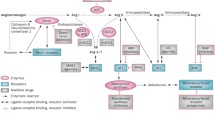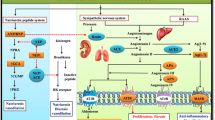Abstract
It is well known that the renin-angiotensin system (RAS) plays a pivotal role in the pathophysiology of cardiovascular diseases. This is well illustrated by the great success of ACE inhibitors and angiotensin (Ang) II AT1 blockers in the treatment of hypertension and its complications. In the past decade, the classical concept of RAS orchestrated by a series of enzymatic reactions culminating in the linear generation and action of Ang II has expanded and become more complex. From the discoveries of new components such as the angiotensin converting enzyme 2 and the receptor Mas emerged a novel concept of dual opposite branches of the RAS: one vasoconstrictor and pro-hypertensive composed of ACE/Ang II/AT1; and other vasodilator and anti-hypertensive composed of ACE2/Ang-(1-7)/Mas. In this review we will discuss recent findings concerning the biological role of the ACE2/Ang-(1-7)/Mas arm in the cardiovascular system and highlight the initiatives to develop potential therapeutic strategies based on this axis for treating hypertension.

Similar content being viewed by others
References
Papers of particular interest, published recently, have been highlighted as: • Of importance •• Of major importance
Unger T. The role of the renin-angiotensin system in the development of cardiovascular disease. Am J Cardiol. 2002;89(2A):3A–9. discussion 10A.
Bader M. Tissue renin-angiotensin-aldosterone systems: targets for pharmacological therapy. Annu Rev Pharmacol Toxicol. 2010;50:439–65.
Nicholls MG, Richards AM, Agarwal M. The importance of the renin-angiotensin system in cardiovascular disease. J Hum Hypertens. 1998;12(5):295–9.
Schiffrin EL. Vascular and cardiac benefits of angiotensin receptor blockers. Am J Med. 2002;113(5):409–18.
Ma TK, et al. Renin-angiotensin-aldosterone system blockade for cardiovascular diseases: current status. Br J Pharmacol. 2010;160(6):1273–92.
Matsusaka T, Ichikawa I. Biological functions of angiotensin and its receptors. Annu Rev Physiol. 1997;59:395–412.
Allen AM, Zhuo J, Mendelsohn FA. Localization and function of angiotensin AT1 receptors. Am J Hypertens. 2000;13(1 Pt 2):31S–8.
de Gasparo M, et al. International union of pharmacology. XXIII. The angiotensin II receptors. Pharmacol Rev. 2000;52(3):415–72.
Vickers C, et al. Hydrolysis of biological peptides by human angiotensin-converting enzyme-related carboxypeptidase. J Biol Chem. 2002;277(17):14838–43.
Tipnis SR, et al. A human homolog of angiotensin-converting enzyme. Cloning and functional expression as a captopril-insensitive carboxypeptidase. J Biol Chem. 2000;275(43):33238–43.
Donoghue M, et al. A novel angiotensin-converting enzyme-related carboxypeptidase (ACE2) converts angiotensin I to angiotensin 1-9. Circ Res. 2000;87(5):E1–9.
Santos RA, et al. Angiotensin-(1-7) is an endogenous ligand for the G protein-coupled receptor Mas. Proc Natl Acad Sci U S A. 2003;100(14):8258–63.
Zisman LS, et al. Angiotensin-(1-7) formation in the intact human heart: in vivo dependence on angiotensin II as substrate. Circulation. 2003;108(14):1679–81.
Ferrario CM, et al. Counterregulatory actions of angiotensin-(1-7). Hypertension. 1997;30(3 Pt 2):535–41.
Ferreira AJ, et al. Therapeutic implications of the vasoprotective axis of the renin-angiotensin system in cardiovascular diseases. Hypertension. 2010;55(2):207–13.
Ferreira AJ, et al. New cardiovascular and pulmonary therapeutic strategies based on the angiotensin-converting enzyme 2/angiotensin-(1-7)/mas receptor axis. Int J Hypertens. 2012;2012:147825.
Bindom SM, Lazartigues E. The sweeter side of ACE2: physiological evidence for a role in diabetes. Mol Cell Endocrinol. 2009;302(2):193–202.
Ferreira AJ, Santos RA. Cardiovascular actions of angiotensin-(1-7). Braz J Med Biol Res. 2005;38(4):499–507.
Santos RA, Ferreira AJ, Simoes ESAC. Recent advances in the angiotensin-converting enzyme 2-angiotensin(1-7)-Mas axis. Exp Physiol. 2008;93(5):519–27.
Kokubu T, et al. Purification and properties of angiotensin I-converting enzyme in human lung and its role on the metabolism of vasoactive peptides in pulmonary circulation. Adv Exp Med Biol. 1979;120B:467–75.
Touyz RM, Berry C. Recent advances in angiotensin II signaling. Braz J Med Biol Res. 2002;35(9):1001–15.
Steckelings UM, Unger T. Angiotensin II type 2 receptor agonists–where should they be applied? Expert Opin Investig Drugs. 2012;21(6):763–6.
Widdop RE, et al. AT2 receptor-mediated relaxation is preserved after long-term AT1 receptor blockade. Hypertension. 2002;40(4):516–20.
Savoia C, et al. Angiotensin type 2 receptor in hypertensive cardiovascular disease. Curr Opin Nephrol Hypertens. 2011;20(2):125–32.
Fyhrquist F, Saijonmaa O. Renin-angiotensin system revisited. J Intern Med. 2008;264(3):224–36.
Bosnyak S, et al. Relative affinity of angiotensin peptides and novel ligands at AT1 and AT2 receptors. Clin Sci (Lond). 2011;121(7):297–303.
Albiston AL, et al. Evidence that the angiotensin IV (AT(4)) receptor is the enzyme insulin-regulated aminopeptidase. J Biol Chem. 2001;276(52):48623–6.
Chai SY, et al. The angiotensin IV/AT4 receptor. Cell Mol Life Sci. 2004;61(21):2728–37.
Schiavone MT, et al. Release of vasopressin from the rat hypothalamo-neurohypophysial system by angiotensin-(1-7) heptapeptide. Proc Natl Acad Sci U S A. 1988;85(11):4095–8.
Rice GI, et al. Evaluation of angiotensin-converting enzyme (ACE), its homologue ACE2 and neprilysin in angiotensin peptide metabolism. Biochem J. 2004;383(Pt 1):45–51.
Brosnihan KB, Li P, Ferrario CM. Angiotensin-(1-7) dilates canine coronary arteries through kinins and nitric oxide. Hypertension. 1996;27(3 Pt 2):523–8.
Sampaio WO, Nascimento AA, Santos RA. Systemic and regional hemodynamic effects of angiotensin-(1-7) in rats. Am J Physiol Heart Circ Physiol. 2003;284(6):H1985–94.
Freeman EJ, et al. Angiotensin-(1-7) inhibits vascular smooth muscle cell growth. Hypertension. 1996;28(1):104–8.
Gava E, et al. Angiotensin-(1-7) receptor Mas is an essential modulator of extracellular matrix protein expression in the heart. Regul Pept. 2012;175(1–3):30–42.
Xu P, et al. Endothelial dysfunction and elevated blood pressure in MAS gene-deleted mice. Hypertension. 2008;51(2):574–80.
Rabelo LA, Alenina N, Bader M. ACE2-angiotensin-(1-7)-Mas axis and oxidative stress in cardiovascular disease. Hypertens Res. 2011;34(2):154–60.
Fraga-Silva RA, et al. The antithrombotic effect of angiotensin-(1-7) involves mas-mediated NO release from platelets. Mol Med. 2008;14(1–2):28–35.
•• Fraga-Silva RA, et al. An orally active formulation of angiotensin-(1-7) produces an antithrombotic effect. Clinics (Sao Paulo). 2011;66(5):837–41. This work shows that the oral formulations Ang-(1-7)-CyD produces biological activity through increasing Ang-(1-7) plasma level and in a Mas-dependent manner.
Fraga-Silva RA, et al. The angiotensin-converting enzyme 2/angiotensin-(1-7)/Mas receptor axis: a potential target for treating thrombotic diseases. Thromb Haemost. 2012;108(6). doi:10.1160/TH12-06-0396.
Santos RA, Campagnole-Santos MJ, Andrade SP. Angiotensin-(1-7): an update. Regul Pept. 2000;91(1–3):45–62.
Silva DM, et al. Evidence for a new angiotensin-(1-7) receptor subtype in the aorta of Sprague-Dawley rats. Peptides. 2007;28(3):702–7.
•• Verano-Braga T, et al. Time-resolved quantitative phosphoproteomics: new insights into angiotensin-(1-7) signaling networks in human endothelial cells. J Proteome Res. 2012;11(6):3370–81. This study provides new concepts and new understanding of the Ang-(1−7) signal transduction, shedding light on the mechanisms underlying Mas activation.
Heitsch H, et al. Angiotensin-(1-7)-stimulated nitric oxide and superoxide release from endothelial cells. Hypertension. 2001;37(1):72–6.
Sampaio WO, et al. Angiotensin-(1-7) through receptor Mas mediates endothelial nitric oxide synthase activation via Akt-dependent pathways. Hypertension. 2007;49(1):185–92.
Sampaio WO, et al. Angiotensin-(1-7) counterregulates angiotensin II signaling in human endothelial cells. Hypertension. 2007;50(6):1093–8.
Greer EL, Brunet A. FOXO transcription factors at the interface between longevity and tumor suppression. Oncogene. 2005;24(50):7410–25.
Zhao Y, Wang Y, Zhu WG. Applications of post-translational modifications of FoxO family proteins in biological functions. J Mol Cell Biol. 2011;3(5):276–82.
Brunet A, et al. Akt promotes cell survival by phosphorylating and inhibiting a forkhead transcription factor. Cell. 1999;96(6):857–68.
Zhu Z, et al. Angiotensin-(1-7) inhibits angiotensin II-induced signal transduction. J Cardiovasc Pharmacol. 2002;40(5):693–700.
Giani JF, et al. Angiotensin-(1-7) has a dual role on growth-promoting signalling pathways in rat heart in vivo by stimulating STAT3 and STAT5a/b phosphorylation and inhibiting angiotensin II-stimulated ERK1/2 and Rho kinase activity. Exp Physiol. 2008;93(5):570–8.
Mercure C, et al. Angiotensin(1-7) blunts hypertensive cardiac remodeling by a direct effect on the heart. Circ Res. 2008;103(11):1319–26.
Gomes ER, et al. Angiotensin-(1-7) prevents cardiomyocyte pathological remodeling through a nitric oxide/guanosine 3',5'-cyclic monophosphate-dependent pathway. Hypertension. 2010;55(1):153–60.
Iyer SN, Ferrario CM, Chappell MC. Angiotensin-(1-7) contributes to the antihypertensive effects of blockade of the renin-angiotensin system. Hypertension. 1998;31(1 Pt 2):356–61.
Iyer SN, et al. Vasodepressor actions of angiotensin-(1-7) unmasked during combined treatment with lisinopril and losartan. Hypertension. 1998;31(2):699–705.
Collister JP, Hendel MD. The role of Ang (1-7) in mediating the chronic hypotensive effects of losartan in normal rats. J Renin Angiotensin Aldosterone Syst. 2003;4(3):176–9.
Kucharewicz I, et al. Antithrombotic effect of captopril and losartan is mediated by angiotensin-(1-7). Hypertension. 2002;40(5):774–9.
Yamada K, et al. Converting enzyme determines plasma clearance of angiotensin-(1-7). Hypertension. 1998;32(3):496–502.
Wiemer G, et al. AVE 0991, a nonpeptide mimic of the effects of angiotensin-(1-7) on the endothelium. Hypertension. 2002;40(6):847–52.
Santos RA, Ferreira AJ. Pharmacological effects of AVE 0991, a nonpeptide angiotensin-(1-7) receptor agonist. Cardiovasc Drug Rev. 2006;24(3–4):239–46.
da Costa-Goncalves AC, et al. AVE 0991, a non-peptide Mas-receptor agonist, facilitates penile erection. Exp Physiol. 2012. doi:10.1113/expphysiol.2012.068551.
Pinheiro SV, et al. Nonpeptide AVE 0991 is an angiotensin-(1-7) receptor Mas agonist in the mouse kidney. Hypertension. 2004;44(4):490–6.
Lemos VS, et al. The endothelium-dependent vasodilator effect of the nonpeptide Ang(1-7) mimic AVE 0991 is abolished in the aorta of mas-knockout mice. J Cardiovasc Pharmacol. 2005;46(3):274–9.
Ferreira AJ, et al. The nonpeptide angiotensin-(1-7) receptor Mas agonist AVE-0991 attenuates heart failure induced by myocardial infarction. Am J Physiol Heart Circ Physiol. 2007;292(2):H1113–9.
Ferreira AJ, et al. Isoproterenol-induced impairment of heart function and remodeling are attenuated by the nonpeptide angiotensin-(1-7) analogue AVE 0991. Life Sci. 2007;81(11):916–23.
Benter IF, et al. Angiotensin-(1-7) prevents development of severe hypertension and end-organ damage in spontaneously hypertensive rats treated with L-NAME. Am J Physiol Heart Circ Physiol. 2006;290(2):H684–91.
Faria-Silva R, Duarte FV, Santos RA. Short-term angiotensin(1-7) receptor MAS stimulation improves endothelial function in normotensive rats. Hypertension. 2005;46(4):948–52.
Carvalho MB, et al. Evidence for Mas-mediated bradykinin potentiation by the angiotensin-(1-7) nonpeptide mimic AVE 0991 in normotensive rats. Hypertension. 2007;50(4):762–7.
Singh Y, Singh K, Sharma PL. Effect of combination of renin inhibitor and Mas-receptor agonist in DOCA-salt-induced hypertension in rats. Mol Cell Biochem. 2012. doi:10.1007/s11010-012-1489-2.
Shemesh R, et al. Discovery and validation of novel peptide agonists for G-protein-coupled receptors. J Biol Chem. 2008;283(50):34643–9.
• Savergnini SQ, et al. Vascular relaxation, antihypertensive effect, and cardioprotection of a novel peptide agonist of the MAS receptor. Hypertension. 2010;56(1):112–20. This recent study was the first indicating that the novel Mas agonist, CGEN-856S, might have a therapeutic value, since it induces vasorelaxation, antihypertensive, and cardioprotective effects.
Lula I, et al. Study of angiotensin-(1-7) vasoactive peptide and its beta-cyclodextrin inclusion complexes: complete sequence-specific NMR assignments and structural studies. Peptides. 2007;28(11):2199–210.
Uekama K. Design and evaluation of cyclodextrin-based drug formulation. Chem Pharm Bull (Tokyo). 2004;52(8):900–15.
•• Marques FD, et al. An oral formulation of angiotensin-(1-7) produces cardioprotective effects in infarcted and isoproterenol-treated rats. Hypertension. 2011;57(3):477–83. This work is the first showing the cardioprotective effects of Ang-(1-7) formulation, Ang-(1-7)-CyD.
• Kluskens LD, et al. Angiotensin-(1-7) with thioether bridge: an angiotensin-converting enzyme-resistant, potent angiotensin-(1-7) analog. J Pharmacol Exp Ther. 2009;328(3):849–54. In this work it was developed the cyclized Ang-(1-7) compound which was proposed as an excellent method to render more resistance against proteolytic breakdown but preserving its activity.
Durik M, et al. The effect of the thioether-bridged, stabilized Angiotensin-(1-7) analogue cyclic ang-(1-7) on cardiac remodeling and endothelial function in rats with myocardial infarction. Int J Hypertens. 2012;2012:536426.
Hernandez Prada JA, et al. Structure-based identification of small-molecule angiotensin-converting enzyme 2 activators as novel antihypertensive agents. Hypertension. 2008;51(5):1312–7.
Ferreira AJ, et al. Angiotensin-converting enzyme 2 activation protects against hypertension-induced cardiac fibrosis involving extracellular signal-regulated kinases. Exp Physiol. 2011;96(3):287–94.
Ferreira AJ, et al. Evidence for angiotensin-converting enzyme 2 as a therapeutic target for the prevention of pulmonary hypertension. Am J Respir Crit Care Med. 2009;179(11):1048–54.
Fraga-Silva RA, et al. ACE2 activation promotes antithrombotic activity. Mol Med. 2010;16(5–6):210–5.
Murca TM, et al. Oral administration of an angiotensin-converting enzyme 2 activator ameliorates diabetes-induced cardiac dysfunction. Regul Pept. 2012;177(1–3):107–15.
Murca TM, et al. Chronic activation of endogenous angiotensin-converting enzyme 2 protects diabetic rats from cardiovascular autonomic dysfunction. Exp Physiol. 2012;97(6):699–709.
Sasaki S, et al. Effects of angiotensin-(1-7) on forearm circulation in normotensive subjects and patients with essential hypertension. Hypertension. 2001;38(1):90–4.
Davie AP, McMurray JJ. Effect of angiotensin-(1-7) and bradykinin in patients with heart failure treated with an ACE inhibitor. Hypertension. 1999;34(3):457–60.
Disclosure
Dr. R.A. Fraga-Silva: grant from the Brazilian Swiss Joint Research Program. Dr. A.J. Ferreira: none. Dr. R.A.S. Santos: one of the authors of the patent “Process of Preparation of Formulations of the Peptide Angiotensin-(1-7) and its Analogues, Agonistic and Antagonists Using Cyclodextrins, Lipossomes and Biodegradable Polymers and/or Mixtures and Products Thereof” - WO/2003/039434.
Author information
Authors and Affiliations
Corresponding author
Rights and permissions
About this article
Cite this article
Fraga-Silva, R.A., Ferreira, A.J. & dos Santos, R.A.S. Opportunities for Targeting the Angiotensin-Converting Enzyme 2/Angiotensin-(1-7)/Mas Receptor Pathway in Hypertension. Curr Hypertens Rep 15, 31–38 (2013). https://doi.org/10.1007/s11906-012-0324-1
Published:
Issue Date:
DOI: https://doi.org/10.1007/s11906-012-0324-1




